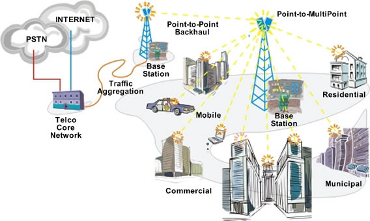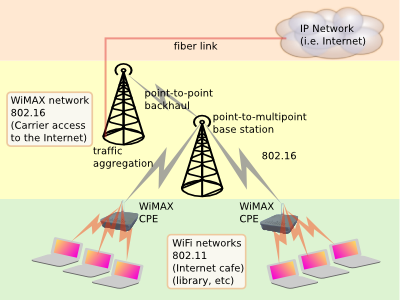Network Considerations
WiMAX technology provides a non-line of sight (NLOS) broadband wireless Internet access system that is flexible enough to support the varying requirements throughout the coverage area - both now and in the future - and does so in the most cost-effective manner. WiMAX networks deliver a price/performance advantage ten times better than competing conventional wireline or cellular broadband network services. Service can be initiated in weeks instead of months or years, using mounting assets such as lampposts and traffic lights (no expensive, time-consuming trenching required). The lead-time to deploy a wired solution is much longer than the lead-time to deploy a WiMAX solution, without offering any accompanying benefits.

The WiMAX linear service range is specified at 31 mi. (50 km). Real world application tests show that 3 to 5 mi. (5 to 8 km) is a more practical figure. Real world connectivity tests achieve data rates between 500kbit/s and 2 Mbit/s, per user (depending on conditions at a given connection point). This is enough bandwidth to support simultaneous Internet Access, VoIP and IP video (surveillance, IPTV) services. WiMAX technology is evolving rapidly thus ensuring significant performance improvements and expanded service opportunities on an ongoing basis.
Wireless network links typically use antennas with a highly focused beam. The antenna can be mounted on masts, which are then mounted on sleds. This is typically done to minimize damage from wind and weather. Antennas can also be mounted directly to the outside of a building. Most antenna mounting systems are constructed and installed to withstand force 3, or 5 hurricanes, which is the same code standard most buildings are held to. Special weather proofing is also provided. In most cases when installing antennas, there are no special building code requirements and it usually does not require a building permit.
In areas with high population densities the range will generally be capacity limited rather than range limited due to limitation in the amount of available spectrum. The base stations are typically backhauled to the core network by means of fiber or point-to-point microwave links or via leased lines from an incumbent wire-line operator. The range and NLOS capability makes the technology equally attractive and cost-effective in a wide variety of environments.
Currently, Wireless Internet Service Providers (WISPs) are the main users of WiMAX technology. A typical WiMAX base station provides service to approximately 60 businesses with T1 access and hundreds of homes with DSL/Cable speed access.
WiMAX vs. WiFi
It is important here to note the differences between WiMAX technology and the more familiar Wi-Fi technology. The basic difference between WiMAX, 802.16 and Wi-Fi, 802.11 (and related standards) is that Wi-Fi is a local area network (LAN) technology; and WiMAX (whether fixed, nomadic, or mobile) is a wide-area network (WAN) technology.

Wi-Fi remains the best way to deploy a network over an office or home or any small area that needs a cloud of service. Wi-Fi is primarily a local distribution tool to connect nearby users. Currently, many solution providers deploy multiple Wi-Fi base stations to achieve seamless coverage on a college campus, City Park, or corporate campus. While Wi-Fi is currently being used for large-scale deployment, this is not the ideal solution since Wi-Fi was not designed for this purpose. It is being adapted for metro-scale service as a matter of convenience, because:
- Everyone already has a Wi-Fi adapter
- The technology works in unlicensed spectrum avoiding that issue
- It is highly commoditized - making parts cheap across the supply chain for consumers, vendors, and network builders
While Wi-Fi will still be used in LAN environments for the foreseeable future, WiMAX was developed specifically to provide wide area network (WAN) connectivity to homes and businesses.
WiMAX vs. Wi-Fi Comparison |
||
|---|---|---|
| Feature | WiMAX | Wi-Fi |
| Time to deploy (client) | 1-2 days | N/A |
| Installation | $0 | N/A |
| Monthly Cost | $190 | From $50 |
| Use | Fixed services | Local Area Network |
| Range | ~1mile NLOS; ~4 miles LOS | ~300 feet |
| Coverage | Metropolitan Area | Only where a hotspot is installed |
| Bandwidth | 1-10MBps symmetric including allocations for specific services | Depends on backhaul circuit; usually ADSL/SDSL 2Mb |
| Latency / Jitter | Configurable for specific application needs | Depends on backhaul, sharing and usage |
| Quality of Service | Committed / Peak / Minimum Information Rate; bursting; jitter and delay control; prioritization | No |
| Contention | Configurable for specific application needs | Set by the backhaul circuit and number of users sharing |
| Service Level Agreement / Guarantee | Yes | No |
| Portability | Yes | Yes |
| Mobility | Yes | No |
| Security | 3DES; AES3 | WEP/WPA; not used on Wi-Fi hotspots |
| Usage | UPLOAD Application support; LAN bridging; Voice services; video services; emails, FTP, VPN and web browsing | Emails and web browsing |